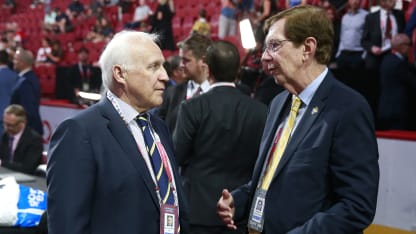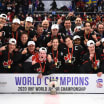The NHL hockey operations department showed the GMs videos of nuances in the game now and new moves that might challenge interpretations of rules in the future.
"It's a compelling product, it's evolving, and you have players doing all sorts of things we wouldn't have even thought about 25, 30 years ago," NHL director of officiating Stephen Walkom said. "We had some unique plays that we could show them, like a player picking the puck up on a shootout attempt and carrying it in lacrosse-style and keeping it below his shoulders. When's it legal? When's it illegal? What can he do when he gets to the net?"
One GM suggested adding video review to see if a player shoots the puck over the glass in the defensive zone, which results in a delay of game penalty. NHL senior executive vice president of hockey operations Colin Campbell said the idea comes up from time to time, but it's difficult to get the right camera angle and consistent TV replays.
One GM suggested reducing the penalty for a failed coach's challenge from a two-minute minor for delay of game to a lost timeout, but that could have unintended consequences. The point of the penalty is to make sure coaches challenge only in obvious situations and to reduce the number of challenges.
The GMs continued some common debates, such as the definition of a distinct kicking motion, which determines whether a goal counts when a puck goes into the net off a skate.
"I said, 'This is 'Groundhog Day' times 10,'" Campbell said. "We've been dealing with it for 25 years, how to address a kicked puck. It's OK until it happens in the second round in the fourth game of the Battle of Alberta. There's going to be different opinions. Two million people north of Red Deer agreed with us, and 2 million people south of Red Deer didn't agree with us. So how do we make that decision easier?"
Walkom said the GMs went over tweaks that have had positive effects. They saw a couple of examples in which the officials called a major penalty on a play that resulted in an injury, then rescinded it after reviewing the play with video and a former referee in the situation room in Toronto.
"That was a small change in the rules, but it worked," Walkom said. "It was good for the game. Nobody wants to see a player hurt, and the refs wanted to be sure they didn't miss anything on the play."
The NHL has seen numerous examples of players better understanding the helmet rule, picking up their helmet, putting it back on and returning to the play instead of automatically leaving the ice. Officials are using common sense enforcing the rule if the puck is in the vicinity and a play can be made, and they also have identified when a player has removed another player's helmet deliberately and called a minor penalty for roughing.
"All these little changes that have been made over time have added up to a great game, and we just want to continue to keep it there," Walkom said.
The GMs looked at goalies knocking the net off the moorings.
"We said, 'Is that a trend -- the goalie, when he's under pressure, knocking the net off -- and if so, how do you want us to deal with it? Do you want us to give him a penalty?'" Campbell said. "They might want us to give him a penalty now, until it happens to them."
Walkom said the NHL will monitor the situation the season goes on, and the GMs will look at it more closely in March, when they break up into small groups to discuss subjects, bring their thoughts to the main group and decide whether to recommend rule changes to the competition committee.
"How's [the net] coming off?" Walkom said. "Is it coming off at a higher frequency? Is it the result of how the goalies are playing, or does it have something to do with technology in the pegs? So we're monitoring that for discussion in March."


















